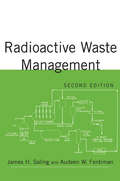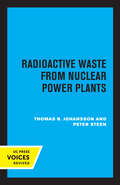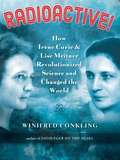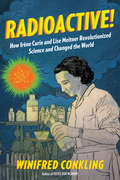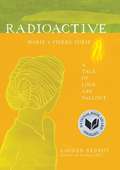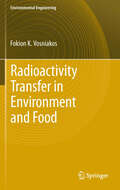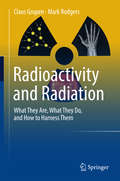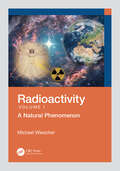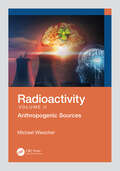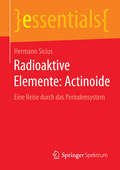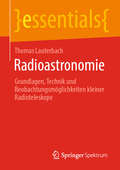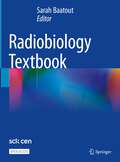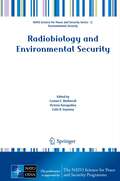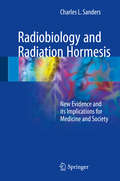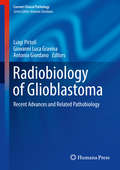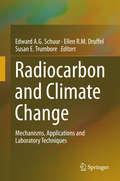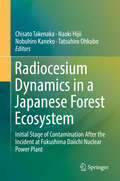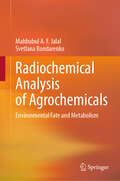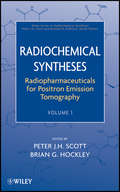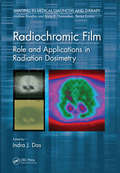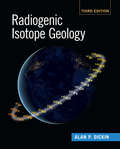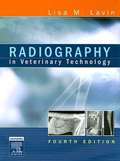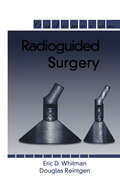- Table View
- List View
Radioactive Waste Management
by James SalingThis reviews sources of radioactive waste and introduces radioactive decay and radiation shielding calculations. It covers technical and regulatory aspects of waste management with discussion questions at the end of each chapter to provide an opportunity to explore the many facets of waste management issues. An extensive reference list at the end of each chapter retains the references from the first edition of the book and incorporates references used in preparing this revised text, giving readers an opportunity to look at historical records as well as current information.
Radioactive Waste from Nuclear Power Plants
by Peter Steen Thomas B. JohanssonThis title is part of UC Press's Voices Revived program, which commemorates University of California Press’s mission to seek out and cultivate the brightest minds and give them voice, reach, and impact. Drawing on a backlist dating to 1893, Voices Revived makes high-quality, peer-reviewed scholarship accessible once again using print-on-demand technology. This title was originally published in 1981.
Radioactive!: How Irene Curie And Lise Meitner Revolutionized Science And Changed The World
by Winifred ConklingThe fascinating, little-known story of how two brilliant female physicists’ groundbreaking discoveries led to the creation of the atomic bomb.<P><P> In 1934, Irène Curie, working with her husband and fellow scientist, Frederic Joliot, made a discovery that would change the world: artificial radioactivity. This breakthrough allowed scientists to modify elements and create new ones by altering the structure of atoms. Curie shared a Nobel Prize with her husband for their work. But when she was nominated to the French Academy of Sciences, the academy denied her admission and voted to disqualify all women from membership. Four years later, Curie’s breakthrough led physicist Lise Meitner to a brilliant leap of understanding that unlocked the secret of nuclear fission. Meitner’s unique insight was critical to the revolution in science that led to nuclear energy and the race to build the atom bomb, yet her achievement was left unrecognized by the Nobel committee in favor of that of her male colleague.<P> Radioactive! presents the story of two women breaking ground in a male-dominated field, scientists still largely unknown despite their crucial contributions to cutting-edge research, in a nonfiction narrative that reads with the suspense of a thriller.
Radioactive!: How Irène Curie and Lise Meitner Revolutionized Science and Changed the World
by Winifred ConklingThe fascinating, little-known story of how two brilliant female physicists’ groundbreaking discoveries led to the creation of the atomic bomb. In 1934, Irène Curie, working with her husband and fellow scientist, Frederic Joliot, made a discovery that would change the world: artificial radioactivity. This breakthrough allowed scientists to modify elements and create new ones by altering the structure of atoms. Curie shared a Nobel Prize with her husband for their work. But when she was nominated to the French Academy of Sciences, the academy denied her admission and voted to disqualify all women from membership. Four years later, Curie’s breakthrough led physicist Lise Meitner to a brilliant leap of understanding that unlocked the secret of nuclear fission. Meitner’s unique insight was critical to the revolution in science that led to nuclear energy and the race to build the atom bomb, yet her achievement was left unrecognized by the Nobel committee in favor of that of her male colleague.Radioactive! presents the story of two women breaking ground in a male-dominated field, scientists still largely unknown despite their crucial contributions to cutting-edge research, in a nonfiction narrative that reads with the suspense of a thriller. Photographs and sidebars illuminate and clarify the science in the book.
Radioactive: Marie & Pierre Curie: A Tale of Love and Fallout
by Lauren RednissA visual journey into the life of Marie Curie, as told through the dazzling collage style of acclaimed author and artist Lauren Redniss “Lauren Redniss creates an entirely new genre of biography.” —Nylon“Visually dazzling…a startlingly original graphic style.” —SlateThe name Marie Curie is enshrined in every schoolchild’s mind as one of the earliest and most inspirational female pioneers in the history of science. Yet the rich, vivid, and romantic story of Marya Salome Sklodwska—the young Polish national who discovered radioactivity—has been lost to time . . . until now, in the pages of this stunning, wildly creative, and uniquely moving visual biography by one of the most creative artistic talents working today. Lauren Redniss, a celebrated New York Times illustrator and storyteller, has thrown herself deeply and passionately into researching the story of the real Marie Curie; of her passionate and tragic romantic life; and of the century of scientific innovation and controversy that sprang from her discovery of radium and went on to change the course of world history. Drawing on her original archival research in Europe and the United States—and a host of new interviews with Curie family members and scientists who carry on the Curie tradition—Redniss has created a fascinating and deeply moving book. A visually stunning work of illustrative art, Radioactive walks the reader through the story of Curie’s own life, which was marked by both extraordinary scientific discovery and dramatic personal trauma—from her romantic partnership with Pierre, through his tragic decline from radium poisoning and death in a traffic accident, to the scandalous affair with another fellow scientist that almost cost her her second Nobel Prize. But it also casts an eye forward, to survey the changes wrought by Curie’s discovery of radioactivity—illuminating the path from the Curie laboratory past the bright red mushroom clouds in the Nevada desert through Three Mile Island and the advance in radiation therapy and nuclear power today. Whether young or old, scientific novice or expert, no one will fail to be moved by Lauren Redniss’s eerie and wondrous evocation of one of history’s most intriguing figures.
Radioactive: Marie And Pierre Curie - A Tale Of Love And Fallout
by Lauren RednissIn 1891, 24-year-old Marie Sklodowska moved from Warsaw to Paris, where she found work in the laboratory of Pierre Curie, a scientist engaged in research on heat and magnetism. They fell in love. They took their honeymoon on bicycles. They expanded the periodic table, discovering two new elements with startling properties, radium and polonium. They recognized radioactivity as an atomic property, heralding the dawn of a new scientific era. They won the Nobel Prize. Newspapers mythologized the couple's romance, beginning articles on the Curies with "Once upon a time... " Then, in 1906, Pierre was killed in a freak accident. Marie continued their work alone. She won a second Nobel Prize in 1911, and fell in love again, this time with the married physicist Paul Langevin. Scandal ensued. Duels were fought.<P><P> In the century since the Curies began their work, we've struggled with nuclear weapons proliferation, debated the role of radiation in medical treatment, and pondered nuclear energy as a solution to climate change. In Radioactive, Lauren Redniss links these contentious questions to a love story in 19th Century Paris.<P> Radioactive draws on Redniss's original reporting in Asia, Europe and the United States, her interviews with scientists, engineers, weapons specialists, atomic bomb survivors, and Marie and Pierre Curie's own granddaughter.<P> Whether young or old, scientific novice or expert, no one will fail to be moved by Lauren Redniss's eerie and wondrous evocation of one of history's most intriguing figures.
Radioactivity Transfer in Environment and Food
by Fokion K. VosniakosThe book deals with various consequences of major nuclear accidents, such as in 1986 in Chernobyl and in 2011 in Fukushima. The public is extremely interested in learning more about the movements and risks posed by radiation in the environment related to food supply and food safety. Radionuclides are found in air, water, soil and even in us not only after nuclear accidents because they occur also in nature. Every day, we ingest and inhale radionuclides in our air and food and the water. This book provides a solid underpinning of the basic physical-chemistry and biogeochemistry of naturally occurring and anthrop radioactivity. The mechanisms of radioactive element transfer in the atmosphere, tropospheric and stratospheric diffusion of radioactivity, environmental contamination from accidents and the impact of atmospheric pollution on the food chain, soil and plants, are analyzed and the analytical methods are illustrated. The question of natural radioactivity concentration in building materials is addressed too. While the book contains many case studies and data for Greece, it is of general value. It contributes to the development of international environmentally safe standards and economically reasonable standard regulations based on justified radiological, social and economical legislation concepts.
Radioactivity and Radiation
by Mark Rodgers Claus GrupenThis book lays the foundations for you to understand all that you always wanted to know about radioactivity. It begins by setting out essential information about the structure of matter, how radiation occurs and how it can be measured. It goes on to explore the substantial benefits of radioactivity through its many applications, and also the possible risks associated with its use. The field of radioactivity is explained in layman's terms, so that everybody who is interested can improve their understanding of issues such as nuclear power, radiation accidents, medical applications of radiation and radioactivity from the environment. Everything is radioactive. There is natural radioactivity in the homes that we live in, the food that we eat and the air that we breath. For over 100 years, people have recognised the potential for radioactivity to help solve problems and improve our standard of living. This has led to the creation of radioactivity levels in some places that are much higher than naturally-occurring background levels. Such high levels of radiation can be harmful to people and the environment, so there is a clear need to manage this potential harm and to make the risk worth the benefits mankind can achieve from radioactive materials.
Radioactivity: A Natural Phenomenon
by Michael WiescherThis book provides an accessible introduction to radioactivity. The first in a two-volume set, this volume is presented in two parts, covering radiation physics and natural radiation exposure.It first explores the discovery and physics of the phenomenon of radioactivity, covering the discovery of radioactive decay and the historical development of the physics and applications of radioactivity through to 1940. Chapters then present descriptive summaries of the physics of the atom and the atomic nucleus, mass and energy conditions, the nature of isotopes, and the different decay patterns. Chapter three discusses decay laws and introduces natural origins of radioactivity as well as methods for producing radioactive isotopes through nuclear reaction processes in reactor and accelerator. The book then provides an introduction on dosimetry, radiation chemistry and impact of radiation on biological systems.The second half of the book details natural radioactivity and the role of radioactivity in the formation of the planetary system and our Earth. The author describes how the inner radioactivity of our planet determines its dynamics and how it could have contributed to the origins of life. The volume concludes with an exploration of the external and internal radioactivity to which humans are exposed and their possible side effects.This book will be of interest to non-science undergraduate and physics graduate students alike, as well as to interested lay-people looking for an introduction to radioactivity. Key Features:- Written in an accessible style, to be understood by readers without a formal scientific education- Highly illustrated throughout- Authored by an expert in the field, drawing from decades of experience in experimental nuclear physics
Radioactivity: Anthropogenic Sources
by Michael WiescherThis book provides an accessible introduction to radioactivity. The second in a two-volume set, this volume is presented in two parts, covering its development and modern applications.It first explores the development and applications of technically enhanced natural radioactivity (TENR) and addresses nuclear energy sources, the fission and fusion processes, and the issues of radioactive fallout from nuclear weapon use and test programs. Later chapters explore the cutting-edge medical applications of radioactive materials in diagnostics and therapy, exploring nuclear medicine technologies such as x-ray tomography, brachytherapy, and positron emission tomography (PET). They also detail the broad range of applications of radioactive materials in industrial production processes, in the sterilization of tools and materials in the medical and the food industries, and in the analysis of art and archaeological material to analyse paintings and painting techniques to identify fakes and forgeries. The book concludes with a discussion of the societal impact and understanding of radioactivity, alongside detailing the underlying reasons for its negative preconceptions and the possible mitigation of these through better education and information practices.This book will be of interest to non-science undergraduate and physics graduate students alike, as well as to interested lay-people looking for an introduction to radioactivity.Key Features:- Written in an accessible style, to be understood by readers without a formal scientific education- Highly illustrated throughout- Authored by an expert in the field, drawing from decades of experience in experimental nuclear physics
Radioaktive Elemente: Eine Reise durch das Periodensystem (essentials)
by Hermann SiciusHermann Sicius bringt dem Leser in knapper Form alle wichtigen Informationen rund um eine wichtige Klasse metallischer Rohstoffe nahe. Von den achtzehn Metallen der Actinoide und der dritten Nebengruppe sind bis auf Thorium, Uran und vielleicht Plutonium alle weitgehend unbekannt, aber trotz ihrer teils extrem aufwendigen Herstellung gibt es hochinteressante Einsatzgebiete dieser oft stark radioaktiven Elemente, und dies auch in nicht-militärischen, d. h. friedlichen Anwendungen. Wussten Sie schon vom Einsatz Americiums in Radionuklidbatterien? Dem Beschuss von Atomen des Einsteiniums mit kleineren Atomkernen zur Erzeugung von Elementen noch höherer Ordnungszahl? Nein? Dann lassen Sie sich die faszinierende Welt dieser schweren Atomkerne vorstellen! Keine Angst vor Radioaktivität! Der Autor beschreibt die gegenwärtige Lage und gibt einen Ausblick in die Zukunft.
Radioastronomie: Grundlagen, Technik und Beobachtungsmöglichkeiten kleiner Radioteleskope (essentials)
by Thomas LauterbachDie Funktechnik ermöglicht die Ausweitung der astronomischen Beobachtungen über das Licht hinaus auf andere Frequenzbereiche. Dies führte zur Entdeckung zahlreicher kosmischer Radioquellen, deren physikalische Ursachen erläutert werden, ebenso die Funktionsweise eines Radioteleskops. Schon mit kleinen Radioteleskopen kann die Strahlung der Sonne und anderer Radioquellen sowie die 21-cm-Strahlung aus der Milchstraße beobachtet werden. Durch Interferometrie kann eine wesentlich höhere Auflösung als mit einzelnen Radioteleskopen erzielt werden. Dadurch kann die radioastronomische Forschung zu vielen aktuellen Fragen der Astronomie, Kosmologie und Physik beitragen.
Radiobiology Textbook
by Sarah BaatoutThis open access textbook focuses on the various aspects of radiobiology. The goal of radiobiological research is to better understand the effects of radiation exposure at the cellular and molecular levels in order to determine the impact on health. This book offers a unique perspective, by covering not only radiation biology but also radiation physics, radiation oncology, radiotherapy, radiochemistry, radiopharmacy, nuclear medicine, space radiation biology & physics, environmental and human radiation protection, nuclear emergency planning, molecular biology and bioinformatics, as well as the ethical, legal and social considerations related to radiobiology. This range of disciplines contributes to making radiobiology a broad and rather complex topic. This textbook is intended to provide a solid foundation to those interested in the basics and practice of radiobiological science. It is a learning resource, meeting the needs of students, scientists and medical staff with an interest in this rapidly evolving discipline, as well as a teaching tool, with accompanying teaching material to help educators.
Radiobiology and Environmental Security
by Carmel E Mothersill Colin B. Seymour Victoria KorogodinaThis volume - like the NATO Advanced Research Workshop on which it is based - addresses the fundamental science that contributes to our understanding of the potential risks from ecological terrorism, i.e. dirty bombs, atomic explosions, intentional release of radionuclides into water or air. Both effects on human health (DNA and systemic effects) and on ecosystems are detailed, with particular focus on environmentally relevant low-dose ranges. The state-of-the-art contributions to the book are authored by leading experts; they tackle the relevant questions from the perspectives of radiation genetics, radiobiology, radioecology, radiation epidemiology and risk assessment.
Radiobiology and Radiation Hormesis
by Charles L. SandersThis book presents new information on radiobiology that more clearly refutes the linear no-threshold (LNT) assumption and supports radiation hormesis. Fresh light is cast on the mechanisms of radiation hormesis and the potential benefits of low-dose ionizing radiation in preventing and treating a wide variety of inflammatory and proliferative diseases. It is proposed that these effects may derive from cellular communication via electromagnetic waves directed by DNA, with each cell acting as a quantum computer. Readers will also find close analysis of the negative impacts of radiophobia on many aspects of modern life, including attitudes to imaging technologies, licensing of nuclear power reactors, and preparedness for survival of nuclear war. The book will be of interest to researchers and scientists in radiobiology, radiation protection, health physics, medical physics, and radiology. Specifically, it will provide medical physicians, radiation oncologists, radiation epidemiologists, gerontologists, cell biologists, toxicologists, and nuclear engineers with a wide range of interesting facts and enlightening novel perspectives.
Radiobiology of Glioblastoma
by Antonio Giordano Luigi Pirtoli Giovanni Luca GravinaThis text properly considers the most recent and relevant advances in molecular RB of GB, taking into account the related topics of pathobiology, and underscores the most promising translational perspectives from the preclinical to the clinical domain. Section I (From Bedside to Bench) discusses conditions associated with RT resistance of GB and the consequent RB hints, technology improvements intended to overcome RT-resistance of GB, mathematical modeling of RB parameters from clinical studies, the present impact of molecular prognostic factors in therapy of GB, and RT tolerance of normal brain. Section II (Preclinical Research and Pathobiology Topics) presents the traditional and mechanistic/molecular approaches to RB of GB, genetic and epigenetic studies on GB, issues of cell-death pathways, stem-like cells, invasiveness, tumor microenvironment, hypoxia, mi-RNA manipulations, and nanoparticle technology. Section III (Translational Perspectives) presents RB issues related to molecular profiling and classification of GB as frames of reference for clinical studies, translational perspectives of gene therapy, evolving protocols based on pre-clinical data and large data-bases and ontologic models. Radiobiology of Glioblastoma: Recent Advances and Related Pathobiology will be of great value to pathologists, medical oncologists, radiation oncologists as well as basic researchers and clinical investigators.
Radiocarbon and Climate Change
by Edward A. G. Schuur Ellen R. M. Druffel Susan E. TrumboreThis book is a useful guide for researchers in ecology and earth science interested in the use of accelerator mass spectrometry technology. The development of research in radiocarbon measurements offers an opportunity to address the human impact on global carbon cycling and climate change. Presenting radiocarbon theory, history, applications, and analytical techniques in one volume builds a broad outline of the field of radiocarbon and its emergent role in defining changes in the global carbon cycle and links to climate change. Each chapter presents both classic and cutting-edge studies from different disciplines involving radiocarbon and carbon cycling. The book also includes a chapter on the history and discovery of radiocarbon, and advances in radiocarbon measurement techniques and radiocarbon theory. Understanding human alteration of the global carbon cycle and the link between atmospheric carbon dioxide levels and climate remains one of the foremost environmental problems at the interface of ecology and earth system science. Many people are familiar with the terms 'global warming' and 'climate change', but fewer are able to articulate the science that support these hypotheses. This book addresses general questions such as: what is the link between the carbon cycle and climate change; what is the current evidence for the fate of carbon dioxide added by human activities to the atmosphere, and what has caused past changes in atmospheric carbon dioxide? How can the radiocarbon and stable isotopes of carbon combined with other tools be used for quantifying the human impact on the global carbon cycle?
Radiocesium Dynamics in a Japanese Forest Ecosystem: Initial Stage of Contamination After the Incident at Fukushima Daiichi Nuclear Power Plant
by Nobuhiro Kaneko Chisato Takenaka Naoki Hijii Tatsuhiro OhkuboThis book investigates radiocesium movement in all major components of forest ecosystems, e.g. the plants, animals, insects, microorganisms, and soils, during the initial stage of contamination after the incident at Fukushima Daiichi Nuclear Power Plant. Most of the work was conducted at a common research site.More specifically, the book examines the contribution of surface uptake by trees in the dynamics of radiocesium during the initial contamination stage; the movement of radiocesium in the form of small organic fragments that are essential to the radiocesium dynamics in forest ecosystems; and the upward movement of radiocesium due to microorganism activity, which promotes the effective decontamination of the forest floor. Lastly, it explains why spiders could be a valuable indicator of the contamination level in forest ecosystems.
Radiochemical Analysis of Agrochemicals: Environmental Fate and Metabolism
by Mahbubul A. Jalal Svetlana BondarenkoThis book provides an in-depth overview of agrochemicals, their development, regulation, and environmental impact. It also offers detailed insights into the latest research methodologies and regulatory standards. Through this comprehensive guide, readers will gain a thorough understanding of the complexities surrounding agrochemical use and its implications for modern agriculture. The chapters cover a wide range of topics including the history and evolution of crop protection methods, the regulatory framework governing agrochemicals, and the intricate processes of degradation and metabolism in various environments. Expert contributors discuss the nuances of radioactivity in agrochemical studies, quantitative and spectroscopic analysis techniques, and the behaviour of these chemicals in soil, water, plants, and livestock. Given its breadth, this book appeals to academics, practitioners, policymakers, and students interested in understanding the scientific principles and practical applications of agrochemicals. Researchers in the fields of agricultural science, environmental chemistry, and regulatory affairs will find this book invaluable.
Radiochemical Syntheses, Radiopharmaceuticals for Positron Emission Tomography
by Michael R. Kilbourn Peter J. Scott Brian G. HockleyThe ultimate reference guide to the synthesis of radiopharmaceuticalsThe Radiochemical Syntheses series provides scientists and professionals with a comprehensive reference to proven synthetic methods for radiochemical reactions, along with step-by-step guidance on how to replicate these syntheses in the laboratory.Volume 1 in the series focuses on the synthesis and purification of radiopharmaceuticals in clinical use today. It brings together in one complete, self-contained volume a collection of monographs containing a wealth of practical information from across the literature, demonstrating in meticulous detail how to prepare radiopharmaceuticals for positron emission tomography (PET) imaging, especially in tumor studies, cardiology, and neuroscience.Readers have key experimental details culled from the literature at their fingertips, greatly simplifying the process of qualifying a site for the clinical production of new radiopharmaceuticals.
Radiochromic Film: Role and Applications in Radiation Dosimetry (Imaging in Medical Diagnosis and Therapy)
by Indra J. DasThis book provides a first authoritative text on radiochromic film, covering the basic principles, technology advances, practical methods, and applications. It focuses on practical uses of radiochromic film in radiation dosimetry for diagnostic x-rays, brachytherapy, radiosurgery, external beam therapies (photon, electron, protons), stereotactic body radiotherapy, intensity-modulated radiotherapy, and other emerging radiation technologies. <P><P>The expert authors address basic concepts, advantages, and the main applications including kilovoltage, brachytherapy, megavoltage, electron beam, proton beam, skin dose, in vivo dosimetry, postal and clinical trial dosimetry. The final chapters discuss the state of the art in microbeam, synchrotron radiation, and ultraviolet radiation dosimetry.
Radiogenic Isotope Geochemistry
by Schaefer Bruce F.Isotopes provide important information on many geological processes, with key relevance to the mining and petroleum industries, yet the techniques to obtain, process and interpret the data can be complex to master. This accessible book provides broad coverage of radiogenic isotopes in geochronology and geochemistry, explaining the basic principles and state-of-the-art techniques used to study them, with an emphasis on industry applications. The major isotopic systems are fully summarised with relation to real-world applications, enabling readers to decide which technique is most relevant for the problem they want to solve, and then to rigorously evaluate existing data, or recalculate and reassess datasets to avoid duplication of effort. A comprehensive glossary clarifies the numerous acronyms used in the field. Written at a level appropriate for advanced undergraduate students, the book also includes detail which allows more experienced practitioners to maximise the potential value of isotopic datasets.
Radiogenic Isotope Geology (3rd Edition)
by Alan P. DickinModern isotope geochemistry is a rapidly expanding field that has a part to play in a broad range of earth and planetary sciences - from extra-solar system processes to environmental geoscience. this new edition of a popular textbook is completely updated and places more emphasis on the uses of radiogenic isotopes in environmental earth science. The author reviews the field of radiogenic isotope geology in a concise and visual manner to provide a comprehensive introduction to the subject and its wide variety of applications. For each technique, current ideas are presented in their historical context to allow the reader to understand the development of the theory. The latest ideas and methods, classic papers and case studies all come under scrutiny within this book. An accessible introduction for scientists from other disciplines and an important reference for students and researchers working in isotope geology.
Radiography in Veterinary Technology 4th Ed
by Lisa M. LavinWritten by a veterinary technician for veterinary technicians, students, and veterinary practice application, this concise, step-by-step text will help users consistently produce excellent radiographic images. It covers the physics of radiography, the origin of film artifacts, and positioning and restraint of small, large, avian, and exotic animals. It discusses everything from patient preparation, handling, and positioning to technical evaluation of the finished product.
Radioguided Surgery
by Eric WhitmanThis handbook is a review of radioguided surgical procedures, including sentinel node mapping and biopsy described by experts in the field. It is a practical guide for the practicing surgeon and other clinicians who will provide the majority of clinical care for breast cancer and other diseases and who therefore must be able to safely and effectively perform these procedures for their patients.
